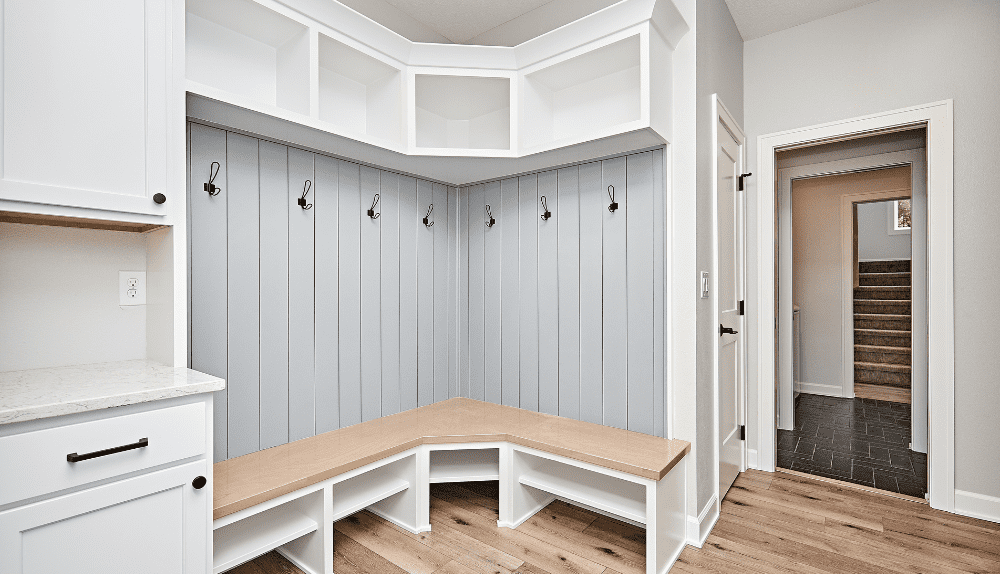The Benefits of Having a Mudroom
- April 14, 2023
- admin
- Category: Home Design, Property Management

Mudrooms have grown in demand in contemporary residences, and it’s a sensible move.
They not only give you a functional area for keeping outdoor items, footwear, and jackets, but they can also help maintain the rest of your dwelling neat and tidy.
Whether you have a large family with lots of outdoor gear or want a designated space for removing and storing your shoes and coats, a mudroom can be a valuable addition to any home.
If you are thinking about enhancing your home with a convenient and functional space, a mudroom comes with a fair share of benefits.
Keep reading to learn about the benefits of having a mudroom in your residence.
What is a Mudroom?
If you’re still getting familiar with the concept of a mudroom, you might be wondering what exactly it is and how it differs from other entryway spaces in the home.
A mudroom is a transitional space between the outdoors and the indoors, where family members can remove and store their outdoor gear, shoes, and coats.
Mudrooms are often located near the primary entrance to the home, such as the front or back door, and are designed to be practical and functional.
So, what are the typical features that you might find in a mudroom? Here are a few examples:
1. Storage Cubbies
One of the primary features of a mudroom is storage space. Many mudrooms include cubbies or lockers where family members can store their shoes, backpacks, and other items. It helps keep the rest of the home tidy and free from clutter.
2. Benches or Seating
Another common feature of a mudroom is a bench or seating area. It provides a convenient place for family members to sit down and remove their shoes or boots and can also serve as a place to put on shoes before heading out the door.
3. Coat Hooks or Racks
Coat hooks or racks are another essential feature of a mudroom. These can be used to hang coats, hats, scarves, and other outdoor gear, making it easy to grab and go when heading out the door.
4. Flooring and Wall Treatments
Mudrooms are often designed with durable materials that withstand dirt, mud, and moisture. It might include tile or vinyl flooring, which is easy to clean and maintain, and wall treatments that can be wiped down as needed.
Overall, mudrooms are highly convenient areas that simplify the lives of active households. By offering a specific location for outdoor equipment, footwear, and outerwear, mudrooms can maintain the tidiness and systematization of the remaining household.
Benefits of Having a Mudroom
As we have previously discussed the purpose and components of a mudroom, let’s delve into its advantages to homeowners. Here are some examples:
1. Decreased Wear and Tear on the Home
Another benefit of having a mudroom is that it can help decrease the wear and tear on the rest of the home. By providing a designated space for removing and storing outdoor gear, mudrooms can help prevent dirt, mud, and snow from being tracked throughout the rest of the home. It can help protect the floors and carpets from damage and reduce the need for frequent cleaning or repairs.
For landlords, having a mudroom can be an especially valuable investment since it can help extend the life of their properties and reduce the need for repairs or renovations. By providing a functional and practical space for tenants to store their outdoor gear, mudrooms can help keep rental properties in good condition for longer, saving landlords money in the long run.
2. Increased Storage Space
One of the primary benefits of having a mudroom is the additional storage space it provides. With cubbies, lockers, shelves, and hooks, there are plenty of places to store outdoor gear, shoes, and coats. It can help keep the rest of the home tidy and free from clutter while making it easier to find what you need when heading out the door.
3. Improved Organization and Cleanliness
Another advantage of having a mudroom is the improved organization and cleanliness it can bring to your home. By providing a designated space for outdoor gear, shoes, and coats, mudrooms can help keep these items from being scattered throughout the rest of the home.
It can also make it easier to keep the home clean since dirt, mud, and snow can be contained in the mudroom rather than tracked throughout the rest of the home.
4. A Space for Pet Supplies and Grooming
If you have pets, a mudroom can be an especially valuable addition to your home. Many mudrooms include space for storing pet supplies, such as leashes, food, toys, and a designated space for pet grooming. It can help keep pet-related messes contained and make caring for your furry friends easier.
5. Added Convenience and Functionality
Finally, having a mudroom can add convenience and functionality to your home, especially if you have a busy household. A mudroom can streamline your daily routine and make it easier to get out the door on time by providing a designated space for removing and storing outdoor gear.
Additionally, your mudroom has additional features like a bench or seating area. In that case, it can provide a comfortable place to put on shoes or chat with family members before heading out for the day.
6. Increased Home Value
A mudroom can add value to your home, especially if it’s well-designed and functional. Many home buyers are looking for homes with practical and convenient features, and a mudroom can be a major selling point. Additionally, if you’re considering selling your home, having a mudroom can make it more attractive to potential buyers and increase its overall value.
7. Personalization and Customization
Mudrooms can be customized to fit your family’s specific needs, making them even more valuable. For example, if you have young children, consider including lower cubbies and hooks they can easily reach. Or, if you have a large family with lots of outdoor gear, include more storage space or additional seating. By tailoring your mudroom to fit your family’s needs, you can create a practical and personalized space.
8. Versatility
Finally, mudrooms can be versatile spaces that can serve multiple functions. In addition to storing outdoor gear, they can also be used as a laundry room, pantry, or workspace. By including additional features like a sink or counter space, you can create a multi-functional space that can be used in various ways.
How to Create a Mudroom?
If you are considering adding a practical mudroom to your living space, consider a few things to ensure it fits your needs. Here are some suggestions and guidance to assist you in initiating the process:
1. Choose the Right Location and Layout
When planning your mudroom, choosing the right location and layout for the space is important. Ideally, your mudroom should be located near the primary entrance to the home, such as the front or back door, and should be designed with a layout that maximizes functionality and flow.
2. Select Durable and Easy-to-Clean Materials and Finishes
Since mudrooms are designed to be a transitional space between the outdoors and the indoors, selecting materials and finishes that are durable and easy to clean is important. Consider using tile or vinyl flooring, which is durable and easy to maintain, and wall treatments that can be wiped down as needed.
3. Incorporate Storage Solutions That Fit Your Needs
Every household is different, so it’s important to incorporate storage solutions that fit your needs. Consider the types of items you’ll be storing in your mudroom, and plan accordingly. It might include cubbies or lockers for shoes and backpacks, coat hooks or racks for outerwear, and shelves or cabinets for storing cleaning supplies, pet supplies, or other items.
4. Include Photos and Diagrams to Help Illustrate the Steps
To help bring your mudroom plans to life, consider including photos and diagrams to help illustrate the steps involved. It can be especially helpful if you plan to DIY your mudroom or work with a contractor to create a custom space.
The Bottom Line
A designated area near the entrance of a house can serve as a practical and aesthetically pleasing mudroom by including elements like compartments for storage, seats, and hooks for hanging coats. It can contribute to maintaining cleanliness and tidiness in the household.
Mentioned throughout this post were some helpful insights for those looking to improve their entryway or organize their belongings in a convenient space.
Following these suggestions, you can optimize your mudroom for the best functionality and design.
FAQs
What is the purpose of a mudroom?
A mudroom is a transitional space between the outdoors and the indoors, where family members can remove and store their outdoor gear, shoes, and coats. The purpose of a mudroom is to provide a practical and functional space for storing outdoor gear and keeping the rest of the home clean and organized.
What features should I include in my mudroom?
Some common mudroom features include storage cubbies, benches or seating, coat hooks or racks, and durable flooring and wall treatments. Additionally, you can incorporate features that fit your specific needs, such as pet supply storage or a laundry area.
How do I create a mudroom in my home?
Choose the right location and layout to create a mudroom in your home. Select durable and easy-to-clean materials and finishes, and incorporate storage solutions that fit your needs. Finally, consider including photos and diagrams to help illustrate the steps involved in creating your mudroom.
Do I need a large home to have a mudroom?
You can use a large home to have a mudroom. Mudrooms can be created in any home, regardless of size. With careful planning and creative use of space, you can create a perfectly tailored mudroom to your needs.
Can a mudroom increase the value of my home?
Yes, a mudroom can be a valuable addition to any home and increase its value. Homebuyers are often attracted to homes with mudrooms, as they provide a practical and functional space for storing outdoor gear and keeping the rest of the home clean and organized.





